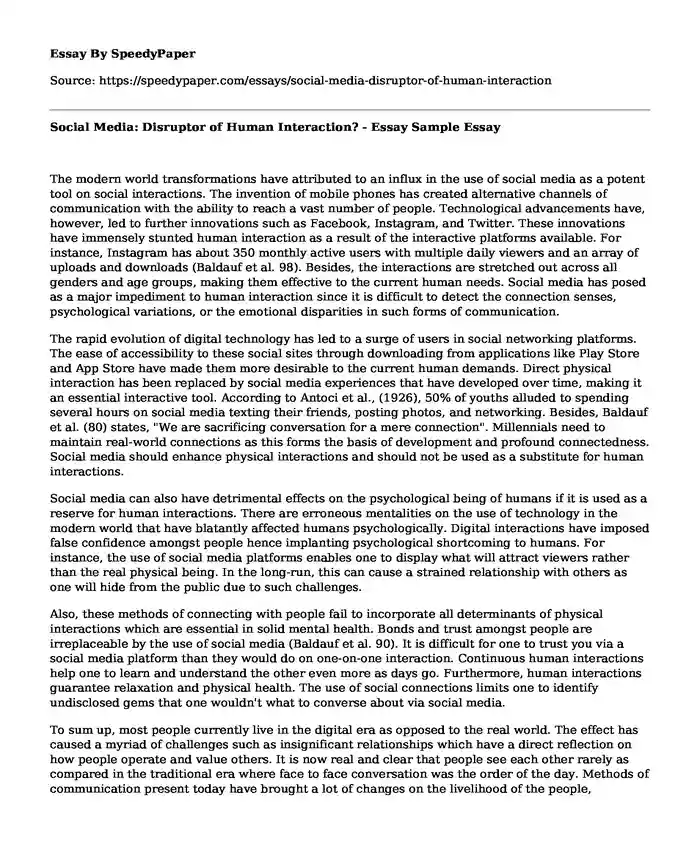
| Type of paper: | Essay |
| Categories: | Entertainment Media Social media |
| Pages: | 3 |
| Wordcount: | 666 words |
The modern world transformations have attributed to an influx in the use of social media as a potent tool on social interactions. The invention of mobile phones has created alternative channels of communication with the ability to reach a vast number of people. Technological advancements have, however, led to further innovations such as Facebook, Instagram, and Twitter. These innovations have immensely stunted human interaction as a result of the interactive platforms available. For instance, Instagram has about 350 monthly active users with multiple daily viewers and an array of uploads and downloads (Baldauf et al. 98). Besides, the interactions are stretched out across all genders and age groups, making them effective to the current human needs. Social media has posed as a major impediment to human interaction since it is difficult to detect the connection senses, psychological variations, or the emotional disparities in such forms of communication.
The rapid evolution of digital technology has led to a surge of users in social networking platforms. The ease of accessibility to these social sites through downloading from applications like Play Store and App Store have made them more desirable to the current human demands. Direct physical interaction has been replaced by social media experiences that have developed over time, making it an essential interactive tool. According to Antoci et al., (1926), 50% of youths alluded to spending several hours on social media texting their friends, posting photos, and networking. Besides, Baldauf et al. (80) states, "We are sacrificing conversation for a mere connection". Millennials need to maintain real-world connections as this forms the basis of development and profound connectedness. Social media should enhance physical interactions and should not be used as a substitute for human interactions.
Social media can also have detrimental effects on the psychological being of humans if it is used as a reserve for human interactions. There are erroneous mentalities on the use of technology in the modern world that have blatantly affected humans psychologically. Digital interactions have imposed false confidence amongst people hence implanting psychological shortcoming to humans. For instance, the use of social media platforms enables one to display what will attract viewers rather than the real physical being. In the long-run, this can cause a strained relationship with others as one will hide from the public due to such challenges.
Also, these methods of connecting with people fail to incorporate all determinants of physical interactions which are essential in solid mental health. Bonds and trust amongst people are irreplaceable by the use of social media (Baldauf et al. 90). It is difficult for one to trust you via a social media platform than they would do on one-on-one interaction. Continuous human interactions help one to learn and understand the other even more as days go. Furthermore, human interactions guarantee relaxation and physical health. The use of social connections limits one to identify undisclosed gems that one wouldn't what to converse about via social media.
To sum up, most people currently live in the digital era as opposed to the real world. The effect has caused a myriad of challenges such as insignificant relationships which have a direct reflection on how people operate and value others. It is now real and clear that people see each other rarely as compared in the traditional era where face to face conversation was the order of the day. Methods of communication present today have brought a lot of changes on the livelihood of the people, especially on the nature of communication in society. Additionally, social media networks and platforms are the major forces that have caused the stunt of traditional forms of interaction.
Work Cited
Antoci, Angelo, Fabio Sabatini, and Mauro Sodini. "Bowling alone but tweeting together: the evolution of human interaction in the social networking era." Quality & Quantity 48.4 (2014): 1911-1927.
Baldauf, Heike, Christine Develotte, and Magali Ollagnier-Beldame. "The effects of social media on the dynamics of identity: Discourse, interaction and digital traces." Alsic. Apprentissage des Langues et Systèmes d'Information et de Communication 20.1 (2017).
Cite this page
Social Media: Disruptor of Human Interaction? - Essay Sample. (2023, Nov 15). Retrieved from https://speedypaper.net/essays/social-media-disruptor-of-human-interaction
Request Removal
If you are the original author of this essay and no longer wish to have it published on the SpeedyPaper website, please click below to request its removal:
- Effects of Social Media - Free Essay for Students
- Problem Solving Essay Example on film Ex Machina
- Reflective Essay on PR Proposal Campaign
- Journalism and Social Media, Essay Sample for Your High Grades
- Steven Pinker "Mind Over Mass Media" - Free Essay
- Free Paper Sample on Media in U.S. President Election
- Are Social Media Really Dangerous? - Paper Example
Popular categories




